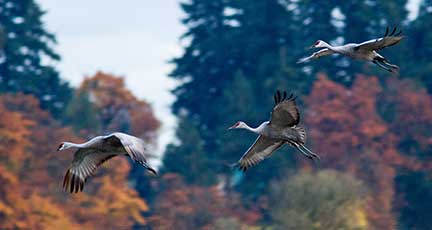 |
Previous Issues |
| Cedar Mill Community Website |
|
Search the Cedar Mill News: |
About The Cedar Mill News |
|
|||||||
| Volume 10, Issue 12 | December 2012 |
||||||
What to Wear???
|
 |
| Sandhill Cranes at Ridgefield ©2012 Jeffrey Young |
On a recent birding outing in Ridgefield National Wildlife Preserve to see Sandhill Cranes, our guide, the local manager of the refuge, was very clear that camouflage clothing was helpful in not spooking the birds. I decided to do some research about this often-repeated bit of advice to see what evidence there was for this recommendation. Before I get to the data, I want to share the observation that the birds knew we were there long before we saw them in their camo coat! They probably heard us or smelled us, and in any event, right after we parked (out of their sight), we heard them moving away from the edge of the lake to the other side. We didn’t even get a chance to check out the various colors of coats!
A Scientific American article from 2006 on “What Birds See” was illuminating. It contained great detail on the color-sensing cells in the retinas of eyes. Birds have many more types of these cells than humans, and most probably can appreciate more depth of color than we can. They can see better in dim light than humans and may be able to “see” other wavelengths, such as ultraviolet, in ways we humans cannot imagine. I then found an article by an ornithologist, Bryon K. Butler, who had opinions based on similar research about how birds see differently than humans. He invited us to consider the world from their point of view if we can imagine it.
Birds have a very high capacity to detect minute movements. Therefore, slow movements, and being still at times, are critical skills to keep birds from flying off. He hypothesizes that birds appreciate reflection more than we humans can. Therefore he says that shininess and UV reflection may be as important as color. (Think about your reflective sunglasses! Or your bling….) He then described how birds are very wary about being looked at directly. He believes this is a survival instinct to avoid predators locating them, so he “breaks up his face” with a hat with a brim and scans around indirectly so as not to scare the birds.
These are evidence-based ideas from scientists. As an avid outdoor person, I would add some more practical ideas, like don’t wear things that make noise. There’s always that person on Audubon birding outings wearing “noisy” nylon rain gear—which can make incredible amounts of noise as the arms swing back and forth and back and forth and back and forth. It’s certain you will not hear any bird sounds with that noise interference, and most likely the birds will hear you before you see them too. Then there is the shoe issue. Hard-soled shoes on gravel make a lot of noise. Opt for something less stylish and more safe and quiet. You won’t be likely to slip and you’ll hear more natural sounds. You need to be comfortable—have plenty of pockets for your insect repellant, your snacks, your camera back-up batteries and other necessities such as bird book etc. You need to be warm and dry so layers are most helpful.
Otherwise I don’t really think that color is the key ingredient unless you WANT to attract hummingbirds—in which case red is the best color. I have personally been “investigated” by my local yard Anna’s Hummingbirds when I was sitting in my back yard in my red shirt.
There is a funny book called Real Birders Don’t Wear White. Well, I can tell you I have worn white shirts and sweaters and seen plenty of birds—the birds see you way before you see them whether you are in camo or white. It’s your behavior that allows you to see birds.
Birdwatching can be a peaceful and calming activity. If instead you choose to rush out and try to “get a glimpse” so you can identify that bird, you may just have scared it off. Instead sit for a bit, don’t judge what others are wearing, and just breathe and enjoy the sounds and the sights. That bird will probably stick around longer so you can enjoy seeing it…
And PS: you don’t have to go to Washington (Ridgefield) to see Cranes. I suggest going there to see Tundra and Trumpeter Swans! You can see many Sandhill Cranes flying overhead in Cedar Mill if you look up. Your clue will be their distinctive “garook” call as they fly along with a flock that sure doesn’t look like geese! During the late fall and early winter they fly further south. Some do stay at Ridgefield and other places like Sauvie Island and an occasional one or two other local areas all winter, but most go to southern California or Mexico for the winter. And then of course in the spring they fly back overhead.
Lauretta Young MD is a retired psychiatrist who now takes people out on birding jaunts to Cedar Mill and beyond. See her on her website at www.portlandbirdwatching.com in her non–camo rain coat! She is the current medical director at OHSU for the Integrative Self Care initiative for students focusing on healthy practices for new physicians to become more resilient. Go outside—there’s evidence it is good for you!
See more of her husband’s photos at www.flickr.com/photos/youngbirders
![]()
Like us on Facebook for timely updates
Published monthly by Pioneer Marketing & Design
Publisher/Editor:Virginia Bruce
503-803-1813
PO Box 91061
Portland, Oregon 97291
© 2012